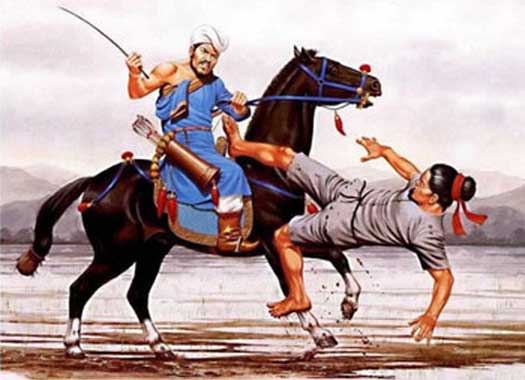
Red Turban warrior fighting a Mongol.
The breakup of the Yuan armies after the dismissal of Toghto permitted the Red Turban movement to revive on the North China plain. At Po-chou in 1355 Liu Fu-t’ung proclaimed Han Lin-erh emperor of a restored Sung dynasty. For almost two years the rebel movement was buffeted by the still-powerful fragments of the disintegrating Yuan military system. Liu Fu-t’ung remained the principal Red Turban leader in terms of actual power; in January 1356, under pressure from Yuan forces, he was forced to move the Sung capital 100 miles to the southwest, to An-feng (near modern Shou-hsien). By 1357 the Yuan were without strong defenders, since Toghto’s organization had collapsed and the subsequently powerful northern regionalists of the 1360s had yet to consolidate their positions. In the interlude, the Red Turbans overran North China. Liu Fu-t’ung with the main army laid siege to K’ai-feng, while other Red Turban armies conquered Shantung and invaded Shensi and Shansi. One force went north of the Yuan capital, burned the summer palaces at Shang-tu, and then invaded Manchuria. K’ai-feng itself fell in mid-1358, and the Red Turbans indulged their Sung fantasies for a year within its walls.
These spectacular Red Turban success had been based on a temporary military vacuum and on the deliberate Yuan policy of not repairing city walls. The Red Turbans proved incapable of establishing viable local or regional regimes based on the defensive strength of the refurbished walls of their North China plain cities, as was happening in South China. The northern Red Turbans retained the roving bandit mentality for too long and made little attempt to maintain discipline or to establish security and a stable administration. Their specifically anti-Confucian religious origins were a hindrance that might have been overcome by a manifest commitment to maintaining order; Chu Yuan-chang’s own career illustrates this possibility, despite the fact that the literati class accepted him only belatedly and reluctantly.
In 1359 the Red Turban position on the North China plain collapsed abruptly as a result of defeats inflicted by the rising militia army of Chaghan Temiir. Chaghan and his boyhood friend Li Ssu-ch’i had begun to raise militia armies in Honan after the original Red Turban rebellions. In the wake of the main Red Turban onslaught of 1357, they drove the Red Turbans out of Shensi and consolidated their power there. In 1359 Chaghan marched east through the T’ung Pass back into the North China plain. In the summer he defeated Liu Fu-t’ung in the field, driving him to take shelter within the walls of K’ai-feng. There Liu held out for three months before breaking out in September and escaping to An-feng with Han Lin-erh and a few hundred soldiers. K’ai-feng then became Chaghan Temiir’s headquarters for future expansion. Since Chaghan’s next goal was Shantung, the Sung court was permitted to linger on at An-feng, a small prefectural city in western Anhwei, until 1363. Nonetheless, after 1359 the Red Turban empire retained a certain importance only because the expanding regional regime of Chu Yuan-chang still adhered nominally to it. The Red Turbans had already fulfilled their historical mission of dominating the North China plain and commanding the attention of the Yuan government for the crucial years from 1355 to 1359, during which the Yangtze regional powers grew to maturity.
Between 1356 and 1367, Chu Yuan-chang began a series of campaigns seeking to defeat his opponents in the Red Turbans. At first, he nominally supported Han Liner to stabilize his northern frontier. Then he defeated his rivals Chen Youliang, Zhang Shicheng and Fang Guozhen one by one. After rising to dominance, he drowned Han Liner. Calling for a racial revolution to overthrow the Mongols and restore the Han Chinese, Chu Yuan-chang gained popular support.
In 1368, Chu Yuan-chang proclaimed himself emperor in Yintian, historically known as the Hongwu Emperor of the Ming Dynasty. The next year, the Ming Army captured Dadu, and the rule of Yuan Dynasty was officially over. China was unified again.